Genre: Puzzle Developer: Sega Ent. Publisher: Sega Ent. Players: 1-2 Released: 1991
In 1989, the original Game Boy launched in America, with Tetris as its pack-in title, and it practically set the world on fire. For years afterward, people were excited about playing Tetris in black-and-white, on the spinach-green screen. People were amazed that the brick-like console was portable, and everyone’s Game Boy seemed to be a little Tetris machine, with murkier green titles available. Sega correctly saw worlds of untapped potential here, eventually launching the Game Gear as a better portable (1991 in the U.S.), with a better pack-in puzzle game, Columns.
Sega did not invent Columns, just like Nintendo did not invent Tetris. Rather, both companies bought the rights to these games at some point and banked on it. Tetris worked well on the Game Boy’s monochrome screen. Later, Sega launched the Game Gear with Columns, not just as a better puzzle game, but also to show off the Game Gear’s colors and back-light. Magazine ads showed Columns’ gems shining in the darkness, as the back-light promised the exciting new ability to play portable video games in the dark!
Columns has appeared in different forms over the years, including the arcade, the Genesis, and the Master System, but it was best-known and -loved as the Game Gear’s pack-in launch title. Likewise, Tetris has seen different forms but was best-known as the Game Boy’s pack-in launch title. With both portables directly competing for a few years there: Columns was supposed to outshine Tetris, which had already been established for years in America’s road trips, camping trips, bedrooms, and playgrounds.
Columns lacked Tetris’ status as a household name, but it was presented as an equivalent that was better, and it’s true: it destroys monochrome Tetris, in just about every way! Despite this fact, Columns never got quite as popular or well-known. In a few short years, the Game Gear would fade away, leaving Nintendo to dominate the hand-held market, with Tetris probably the best-known puzzle game to this day. Columns now seems mostly forgotten and eclipsed by a modern era of free online jewel games, which sprang up when the Internet took off in the late ’90s, as simple games that could get people to stay on websites like Yahoo! or America Online (AOL.com). Columns may be mostly forgotten, but it’s probably the single title most responsible for sparking this never-ending glut of online jewel games!
While Tetris is famous for different-shaped blocks falling and needing to be arranged (so they fit together, and vanish), Columns’ falling gems are always in vertical stacks of three, and each “column” can have its colors rotated through. It’s a matter of personal preference whether this is more fun than arranging Tetris’ gray blocks, but I definitely prefer sorting colors. Both titles are unique and roughly equivalent, but only one emphasizes beautiful graphics as a fundamental part of the gameplay.
Columns is simple and addictive, like any good puzzle game. Compared to Tetris, there is the sense that each game is mostly using a different part of the brain, and it’s patently true: sorting shapes is indeed a different mental process, from sorting colors. As I play Columns, I tend to find myself mentally devoting a section of the screen to each color. For example, I might aim to place red gems on the left side, blue on the right, and try to give the other colors their own spots in between. This makes the gameplay intuitive and instinctive without over-thinking every single jewel. There will always be a few that don’t match the rest, but if one color is emphasized the most, then it should work out. As gems combine and vanish, they often cause chain reactions of more gems matching and clearing out all by themselves. Progress sometimes also makes a magic jewel drop down, which clears the screen of whatever color it connects to.
This version of Columns is unique for its exclusive background imagery. A cityscape is seen in the distance as we start, in full daylight. The city is a bit indistinct and could be interpreted differently: It mostly looks like an ancient city, but it could also be interpreted as a futuristic city.
For each level of progress, the landscape has a slight change in colors to show the passage of time. We begin in full daylight, which soon starts fading, then passing through a couple warm shades that imply sunset (levels three and four). The stars and crescent moon start to shine through the warm twilight (of level five), then dusk grows deeper (through level six and seven). Finally, (on level eight) the crescent moon magically becomes a full moon, more stars scatter throughout the rest of the darkening sky, and it culminates in deep purple midnight (of level nine). The ancient city’s windows glow with warm light, presumably from candles and fireplaces. The music also speeds up for each level, until it reaches its top speed on level nine; however, the music never becomes stressful or hectic. As the songs get faster, they still sound peaceful and mysterious, just livelier.
The soundtrack shares the same quirk as the Master System version. Some of the higher notes cut out when the sound effects happen. This is obviously unintentional and comes from the sound effects being programmed to use the same sound channels as parts of the music, so that only one or the other can play at a time. This could be considered poor programming, given that both the Master System and its cousin, the Game Gear, were fully capable of playing sound effects at the same time as music!
But I don’t mind this quirk because the music doesn’t get ruined by the higher notes cutting out. The three songs still sound beautiful anyway, and the repeating sound of jewels vanishing is pleasant. (I never know how to describe this sound effect, but somehow it sounds exactly like jewels would sound, if they were magically sparkling and vanishing.) The music sounds full and beautiful, and if the fullness of its sound somehow required those specific channels to be used with cut-outs for sound effects, then it was worth it, for such great music.
Also, I’ve actually grown to love that audio quirk. Everything comes together for a beautiful experience, and the audio cut-outs seem to make the music an interactive experience. We can decide when exactly to drop each column, to trigger the sound effects and make the higher notes cut out. For example, if the main theme is about to start over in a moment, then the current column might as well connect right at the start of the main theme and blank it out at that exact moment. While this obviously has no bearing on gameply, it seems very natural to try to match up the blank-outs with certain points in the song; At least, it seems more natural than not matching it up, and just having the theme blank out sporadically! There is something satisfying about willfully manipulating the music, with every match causing the deeper notes to be emphasized.
It could even resemble synesthesia, the phenomenon of one sense triggering a different sense, as here we have the visuals combining and vanishing, which trigger us to hear the music differently! I can’t think of any other game I’ve played where the music is directly changed so often by the graphics. We may even feel that our emotions are somehow being stirred up, and we might find our eyes tearing up, without being quite sure why – synesthesia, indeed!
When we become moderately skilled at Columns (on default settings), then every game ends the same. The levels pass by quickly, so that level nine is reached in a few minutes. Then we hang out in level nine until the jewels inevitability pile up and end the game within the next few minutes. Since level nine always lasts longer than the previous levels, it becomes the main memory of the experience. This is fine, because the starry night is pretty, and the columns still fall at a reasonable speed, so it’s always possible to survive for a few minutes. It never gets impossible like on the Genesis, where the gems eventually drop to the bottom almost instantly, which is nerve-wracking! On Game Gear, the slower top-speed is still comfortable somehow, while it still always brings the pile-up to end the game soon.
It also gives a natural time frame to each individual game, which will probably only last six or seven minutes. Playing Columns for an extended time always involves a handful of separate games played in succession. It keeps the gameplay fresh, especially visually, since the distant city is always fading from daylight to midnight. It always seems worthwhile to start a new game and see the city in full sunshine again and to hear the music slower and calmer, all of it ready to change subtly, with the slightest bit of progress.
This is arguably the very best version of Columns. While the Master System port has most of the same music, it lacks the cityscape background (it has a couple cool backgrounds of its own, but they’re not quite as cool). The Genesis version has sharper graphics and music, of course, but with plain backgrounds, and it ends with the columns falling so fast that each game becomes stressful. Also, the arcade version looks nearly identical to the Genesis version (plus it’s so rare that most people have never seen it). As strange as it might sound, the Game Gear’s simple beauty and cityscape background, make it seem superior to every other version.
When using Game Gear in the dark, there’s nothing that could be prettier than glowing crystals falling through the darkness! It resembles stained-glass windows glowing bright in a dark church, and that impression goes along with the church-like pipe organ music. The gameplay has a disembodied feel, as there is nothing on-screen to identify with. It feels like sitting in a church and being able to manipulate the stained-glass windows’ shapes and colors, just by one’s mind. The experience is dream-like.
Likewise, the gameplay can lend itself to profound thoughts. Sometimes I think about different ways of interpreting what the jewels can represent. (Sure, they can just be jewels, of course, but besides that.) The cityscape can lead to related interpretations. The gems can represent all the activities happening in that tiny, ancient city. We’re seeing it from a couple miles away, but if we were closer, we’d be able to see the bustling marketplace with thousands of people selling and buying loaves of bread, baskets of fish, and ceramic jugs of wine! All of it can be symbolized by the endless stream of crystals, representing all those little activities.
For example, some gems could represent some crops being sold, while other gems could represent thieves stealing money from some other vendors, who were distracted by gazing at the sunset. Some gems could represent star-crossed lovers sneaking out of their parents’ houses, to enjoy each other’s embrace in the midnight darkness (of level nine), while somewhere else, some gems could represent people crying over their break-ups and divorce. A wedding party takes place; a funeral. Somewhere, the most beautiful girl in the city is brushing her golden hair and putting on glittering make-up, because she’s going to give her boyfriend the best night of his life.
If the crystals represent all the thousands of activities of daily life in the ancient city, it becomes emotional and heart-breaking. Just look at all these countless hopes and dreams that all these people are struggling through! Look at all their hours of hard labor. Is any of it worth it? For some people it is, but for others it isn’t. This particular day in the city will be great for some folks but not for others. So many dreams and aspirations, each with its own struggle!
There is also something profound about seeing each jewel as symbolic of a separate little part of life. We know that every single effort will not be successful – some of our efforts will be unsuccessful – yet we are still considering each experience as a jewel. It suggests that every activity in life – and maybe every moment of life – has its own beauty, regardless of its outcome and also, regardless that each moment’s beauty might soon by vanishing like a pile of same-colored gems! When all is said and done, life seems best defined by its best moments, its best crystallized memories, even if those peak experiences might vanish quickly, leaving us alone with the empty, starry sky.
Can any other puzzle game lead to such reflections, or such emotions that make us tear up, for so many ancient people struggling through another hard day in the marketplace? The answer is no. There is no comparable version of Columns, let alone any comparable puzzle game.
Additionally, there are a handful of options that I’ve never used much, but which could add to the replay value. Two-player versus mode should be a guaranteed good time, if two friends, two Game Gears, two Columns carts, and a link cable ever happen to pile up in the same area. “Flash Columns” involves clearing out a pile of jewels, to reach one that’s flashing. It’s fine but isn’t very different from normal gameplay. We can also always choose to start at an advanced level, instead of starting at level zero (I never choose to do so, because I enjoy the flow of the gameplay, as it is).
While the background is always the same scenery, there’s the choice of changing the gems into different objects (like on the Master System, which has the same choices) – blocks, fruit, dice, or playing-card symbols, none of which look quite as good as the default columns of jewels. Blocks are probably the best alternative, because then the game looks like an extremely colorful version of Tetris. The playing-card symbols and fruit are also decent-looking, but they’re slightly harder to see clearly because the objects (and their details) are so small. The faces of the dice are the very hardest to see, so it’s the least playable choice.
Also, there’s a choice of increasing or decreasing the number of different jewels (or objects) to sort, and it’s funny that this option might go unnoticed by most people because the options screen only shows the choices of NORMAL, EASY, or HARD. Most folks might not realize that this option is actually for changing the number of gems. NORMAL is five unique gems, EASY is four, and HARD is six, with that sixth being a new gold diamond thrown in there. If we’re using blocks instead of jewels, the new sixth block is magenta-pink. For the playing-card symbols, it’s a new blue diamond, and for the fruit it’s a green apple (or something). In all these cases, the sixth object is a nice extra color, added to an already-colorful game, and this is reason enough to stick with HARD mode. (For the dice, the sixth is a die whose face shows six purple dots, but again, the dice are just too small to see easily, so it’s not really a choice.)
I didn’t expect HARD mode to change the gameplay much, just by adding one more jewel to the mix, but surprisingly, it does ramp up the difficulty, much more than I would have expected! The sixth gem suddenly makes the well seem too small, crowded, and claustrophobic. It’s only six spaces across, so it’s almost impossible to devote a different space for each of the six colors (whereas in NORMAL mode, it’s much easier to sort five colors, in that space). The HARD setting is more chaotic and remains a healthy challenge.
We can also choose which of the three pipe organ songs to enjoy, identified only as A, B, and C (probably because of the limited screen-size). The Master System seems to have the same exact versions of the first two songs, complete with that glitch of the high notes cutting out for sound effects (it has a different third song, but it’s not as good). On the Master System, the songs are never named at all, strangely enough, as the music just goes along with the modes of gameplay chosen.
But fans of Genesis Columns will recognize the soundtrack as the same exact songs, just in simplified form. From Genesis, we know the songs are named after the Three Fates of Ancient Greece – the three white-robed incarnations of destiny, who were imagined to direct each person’s life. Song A is Clotho, B is (the misspelled) Lathesis, and C is Atropos. While these songs probably have nothing to do with Greek mythology beyond their names, I do appreciate that the names might prompt us to look into it, just to see what they mean.
All the music is great, and the first song (Clotho) is the most familiar and most classic. There might be replay value in occasionally switching songs, but when I do, I always soon run back to the arms of Clotho, whose song seems best – or maybe that’s just because it’s the most familiar and nostalgic. In directly comparing these songs to their 16-bit counterparts, I actually prefer the 8-bit versions, which sound softer, warmer, and more emotionally-moving (while the 16-bit versions sound sharper, more complex, and more realistic).
Arguably the definitive version of Columns, we can almost hear the waves lapping in the ancient Mediterranean, feel the sun on our skin, and breathe in the cool freshwater breeze. With beautiful imagery even printed on the cartridge and box, Columns is a gem that belongs in every Game Gear collection.
SCORE: 9 out of 10

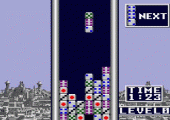
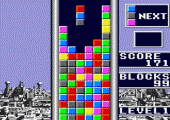
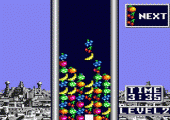
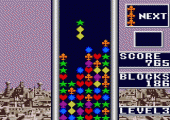
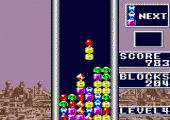
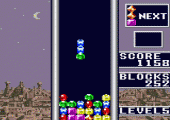
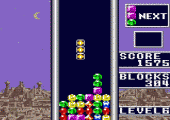
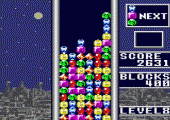
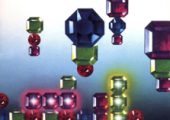
Recent Comments